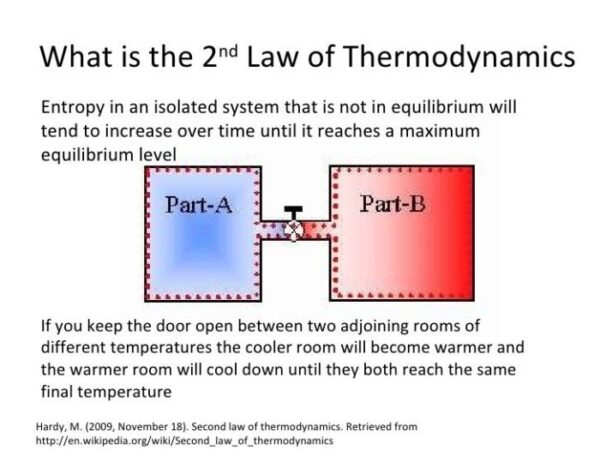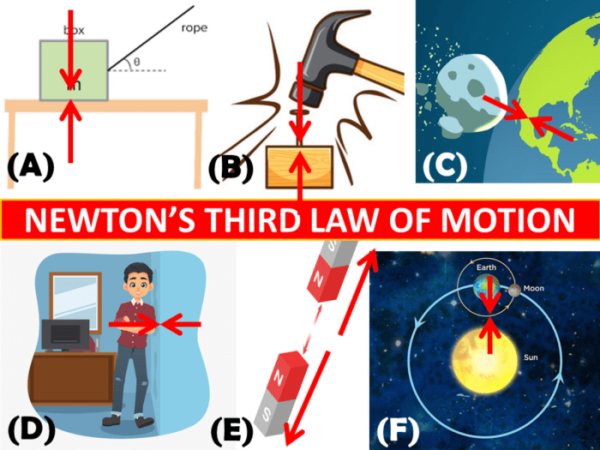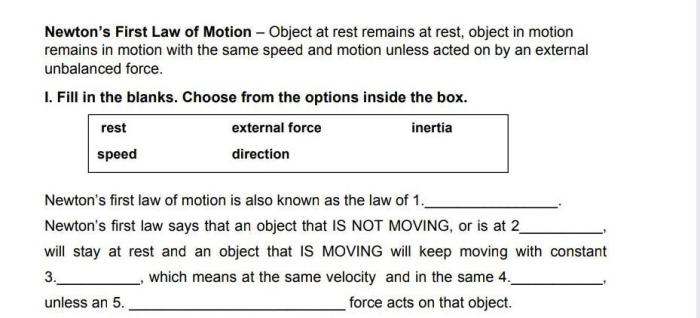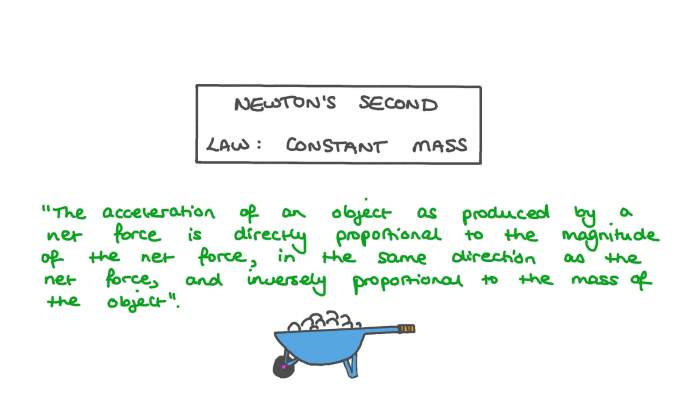
What are the three laws of motion? These fundamental principles, established by Sir Isaac Newton, form the bedrock of classical mechanics, governing the movement of objects in our everyday world. They explain why a ball thrown in the air eventually falls back down, how a car accelerates when you press the gas pedal, and why a rocket can launch itself into space. By understanding these laws, we gain a deeper appreciation for the intricate workings of the universe around us.
From the simple act of walking to the complex motions of planets in our solar system, Newton’s laws of motion provide a framework for comprehending the dynamics of objects. These laws are not merely theoretical concepts; they have practical applications in various fields, including engineering, aerospace, and sports. They help us design safer vehicles, launch satellites into orbit, and understand the mechanics of athletic movements.
Introduction to Newton’s Laws of Motion
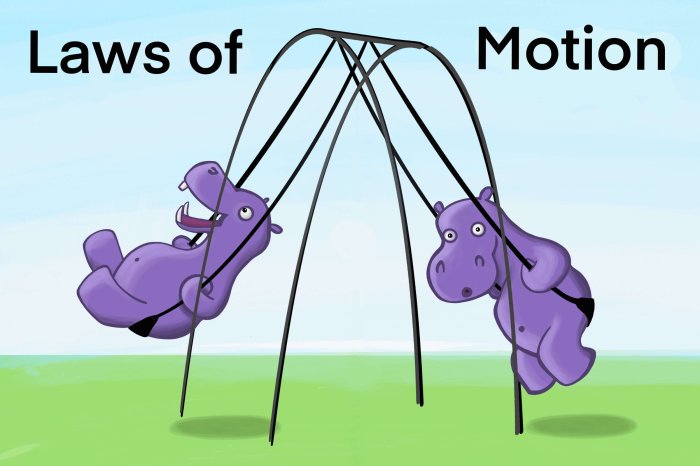
Sir Isaac Newton, a renowned physicist and mathematician, revolutionized our understanding of motion with his groundbreaking laws of motion. These laws, formulated in the 17th century, form the foundation of classical mechanics, a branch of physics that deals with the motion of objects under the influence of forces.
Newton’s Laws of Motion and Their Significance
Newton’s laws of motion are fundamental principles that describe the relationship between forces and the motion of objects. They are essential for understanding and predicting the behavior of objects in our everyday world. From the motion of a ball thrown in the air to the movement of planets in our solar system, Newton’s laws provide a framework for explaining these phenomena.
Historical Context of Newton’s Laws of Motion
Prior to Newton’s work, the understanding of motion was based on the ideas of ancient Greek philosophers like Aristotle. Aristotle believed that a force was required to keep an object in motion, and that objects naturally came to rest. However, Newton’s observations and experiments challenged these long-held beliefs.
Newton’s laws of motion marked a significant shift in our understanding of the universe, replacing Aristotelian ideas with a more accurate and comprehensive model.
Newton’s laws were a product of his careful observations and experiments, and they were built upon the work of earlier scientists like Galileo Galilei. Galileo’s experiments with inclined planes demonstrated that objects in motion tend to stay in motion unless acted upon by a force. This observation was crucial for Newton’s formulation of his first law of motion.
First Law of Motion
The first law of motion, often called the law of inertia, describes the tendency of an object to resist changes in its state of motion. This means that an object at rest will remain at rest, and an object in motion will continue moving at a constant velocity unless acted upon by an external force.
Inertia and Mass
Inertia is directly proportional to an object’s mass. This means that the more massive an object is, the more inertia it possesses, and the harder it is to change its state of motion.
An object’s inertia is its tendency to resist changes in its state of motion.
The more massive an object is, the more inertia it possesses.
Inertia in Action
Inertia is a fundamental concept in physics, and it plays a crucial role in many everyday situations. Here are some examples of inertia in action:
- A passenger in a car during sudden braking: When a car suddenly brakes, the passengers continue to move forward at the same speed as the car was traveling before the brakes were applied. This is because the passengers have inertia and resist the change in motion.
- A ball rolling on a smooth surface: A ball rolling on a smooth surface will continue to roll in a straight line at a constant speed unless acted upon by an external force, such as friction or a bump in the surface. This is because the ball has inertia and resists changes in its motion.
- A book resting on a table: A book resting on a table will remain at rest unless acted upon by an external force, such as a push or a pull. This is because the book has inertia and resists changes in its state of motion.
Second Law of Motion
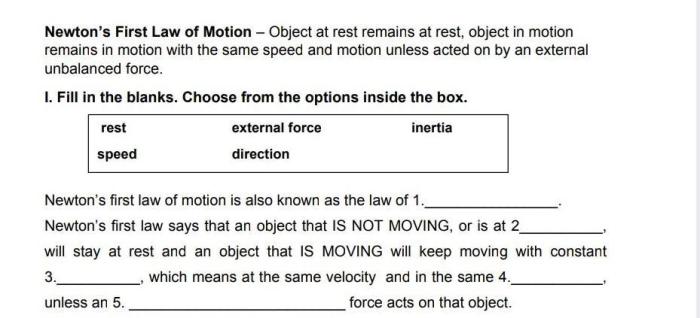
Newton’s Second Law of Motion, often referred to as the law of acceleration, delves into the relationship between force, mass, and acceleration. It provides a fundamental understanding of how objects move in response to forces acting upon them.
Force and Acceleration
Force is a push or pull that can cause an object to change its motion. Acceleration is the rate of change of velocity, meaning how quickly an object’s speed or direction changes. The relationship between force and acceleration is directly proportional, meaning that a larger force produces a larger acceleration.
Relationship Between Force, Mass, and Acceleration
Newton’s Second Law of Motion states that the acceleration of an object is directly proportional to the net force acting on it and inversely proportional to its mass. This can be represented by the following formula:
F = m * a
Where:
* F represents the net force acting on the object.
* m represents the mass of the object.
* a represents the acceleration of the object.
This formula implies that:
* A larger force applied to an object will result in a greater acceleration.
* A heavier object will require a greater force to achieve the same acceleration as a lighter object.
Scenario Illustrating the Second Law of Motion, What are the three laws of motion
Imagine a car of mass 1000 kg accelerating from rest to a speed of 20 m/s in 10 seconds. To calculate the force required to achieve this acceleration, we can use the following steps:
1. Calculate the acceleration:
* Acceleration = (Final Velocity – Initial Velocity) / Time
* Acceleration = (20 m/s – 0 m/s) / 10 s
* Acceleration = 2 m/s²
2. Calculate the force:
* Force = Mass * Acceleration
* Force = 1000 kg * 2 m/s²
* Force = 2000 N (Newtons)
Therefore, a force of 2000 Newtons is required to accelerate the car from rest to 20 m/s in 10 seconds. This scenario demonstrates how Newton’s Second Law of Motion can be applied to real-world situations to predict the motion of objects.
Third Law of Motion
Newton’s third law of motion, also known as the law of action and reaction, is a fundamental principle in physics that describes the interactions between objects. It states that for every action, there is an equal and opposite reaction. This means that when one object exerts a force on another object, the second object exerts an equal and opposite force back on the first object.
Examples of Action-Reaction Pairs
The third law of motion has many implications for how forces interact in nature. Understanding this law is crucial for explaining a wide range of phenomena, from the simple act of walking to the complex workings of rocket engines.
- Rocket Launching: A rocket engine expels hot gas downward, creating an action force. The reaction force pushes the rocket upward, propelling it into space. The force exerted by the rocket on the gas is equal in magnitude and opposite in direction to the force exerted by the gas on the rocket.
- Swimming: A swimmer pushes water backward with their arms and legs, creating an action force. The reaction force from the water pushes the swimmer forward, propelling them through the water.
- Walking: When you walk, your foot pushes backward on the ground, creating an action force. The ground pushes forward on your foot, creating a reaction force that propels you forward.
Importance of the Third Law
The third law of motion is essential for understanding how forces interact in nature. It helps to explain why objects move, how forces are transmitted, and why momentum is conserved in closed systems. For example, in a closed system, the total momentum before and after an interaction remains constant. This is because the action and reaction forces are equal and opposite, resulting in a net momentum change of zero.
Applications of Newton’s Laws of Motion: What Are The Three Laws Of Motion

Newton’s laws of motion are fundamental principles that govern the movement of objects in our universe. They form the foundation of classical mechanics and have profound implications across various fields, from engineering and aerospace to sports and astronomy.
Engineering
Newton’s laws are indispensable in various engineering disciplines. They are used to design and analyze structures, machines, and vehicles, ensuring their stability, efficiency, and safety.
- Structural Engineering: Newton’s laws help engineers determine the forces acting on buildings, bridges, and other structures, enabling them to design robust and safe structures that can withstand various loads and environmental conditions.
- Mechanical Engineering: Engineers apply Newton’s laws to analyze and design machines, engines, and other mechanical systems. They use these laws to calculate forces, torques, and moments, optimizing performance and efficiency.
- Aerospace Engineering: Newton’s laws are crucial in aerospace engineering, particularly in designing aircraft and spacecraft. They are used to calculate lift, drag, thrust, and other forces acting on these vehicles, ensuring safe and efficient flight.
Aerospace
Newton’s laws play a pivotal role in understanding and predicting the motion of celestial bodies, from planets and stars to satellites and spacecraft.
- Orbital Mechanics: Newton’s law of universal gravitation describes the force of attraction between any two objects with mass. This law is fundamental to understanding the motion of planets around the sun, satellites around the Earth, and other celestial bodies in orbit. Engineers use this law to design and launch satellites and spacecraft, ensuring they maintain their orbits and achieve their missions.
- Spacecraft Propulsion: Newton’s third law of motion, which states that for every action, there is an equal and opposite reaction, is the principle behind rocket propulsion. By expelling mass in one direction, a rocket generates thrust in the opposite direction, propelling it through space. Engineers use this principle to design and optimize rocket engines, ensuring efficient and powerful propulsion for spacecraft.
Sports
Newton’s laws are essential in understanding and optimizing athletic performance. They provide insights into the forces involved in various sports activities, helping athletes improve their techniques and maximize their potential.
- Running: Newton’s second law of motion, which states that the acceleration of an object is directly proportional to the net force acting on it and inversely proportional to its mass, explains the relationship between force, mass, and acceleration in running. Athletes can use this principle to optimize their stride length and running form, maximizing their speed and efficiency.
- Jumping: Newton’s third law of motion explains the principle behind jumping. When an athlete pushes off the ground, they exert a force downward, and the ground exerts an equal and opposite force upward, propelling them into the air. Athletes can use this principle to maximize their jump height and distance by applying the appropriate force and technique.
- Ball Sports: Newton’s laws are essential in understanding the motion of balls in sports like baseball, basketball, and soccer. They help athletes predict the trajectory of the ball, determine the forces involved in hitting or kicking the ball, and optimize their strategies for catching or scoring.
Applications in Different Fields
| Law | Engineering | Aerospace | Sports | Other Fields |
|---|---|---|---|---|
| First Law of Motion (Inertia) | Designing structures to withstand inertial forces | Maintaining the motion of spacecraft in orbit | Maintaining momentum in running and swimming | Understanding the motion of objects in everyday life, like a car moving at a constant speed |
| Second Law of Motion (F = ma) | Calculating forces and accelerations in machines and structures | Designing rocket engines and calculating spacecraft trajectories | Analyzing the forces involved in jumping, throwing, and hitting | Understanding the relationship between force, mass, and acceleration in various phenomena |
| Third Law of Motion (Action-Reaction) | Designing propulsion systems for vehicles and aircraft | Understanding the principle behind rocket propulsion | Optimizing techniques for jumping and hitting | Explaining the recoil of a gun and the motion of a boat in water |
Closing Notes
Newton’s three laws of motion are a testament to the power of observation and mathematical reasoning. They have revolutionized our understanding of the physical world and continue to play a crucial role in scientific advancements. By grasping the concepts of inertia, force, and action-reaction, we gain a deeper understanding of the universe and its intricate workings. Whether you are a budding scientist, an engineer, or simply curious about the world around you, studying Newton’s laws of motion offers a fascinating journey into the heart of physics.
Helpful Answers
What is the difference between mass and weight?
Mass is a measure of the amount of matter in an object, while weight is a measure of the force of gravity acting on that object. Mass is constant, while weight can vary depending on the gravitational field.
How does friction affect Newton’s laws of motion?
Friction is a force that opposes motion. It can affect the acceleration of an object, making it harder to start moving or to stop once it is in motion. Friction is a significant factor in real-world applications of Newton’s laws.
What are some examples of Newton’s laws of motion in everyday life?
Examples include a car accelerating when you press the gas pedal (second law), a book staying at rest on a table unless you push it (first law), and a rocket launching into space (third law).
